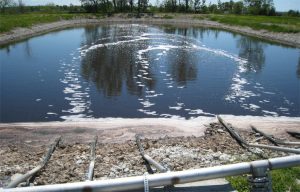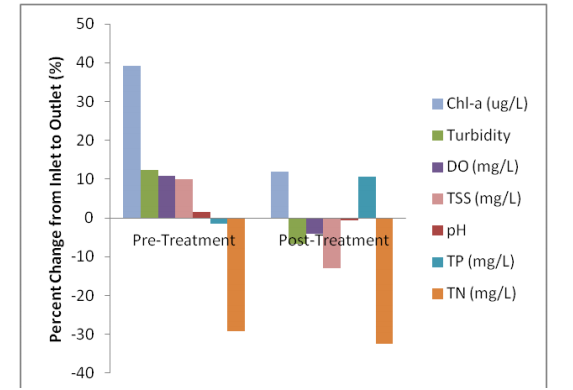Biological Treatment of Seven Storm Water Retention Ponds
Storm Water Treatment
A city of Western Canada had built a series of storm water retention ponds. These were used to improve storm water quality, preserve natural hydrology and mitigate the impacts of urban development. These ponds also functionned as the centerpiece to the development of the area, providing aesthetic qualities to the town as well as irrigation services.
Print-friendly 1-pager: Biological Treatment of Storm Water Retention Ponds (PDF)
Issue
Due to the physiochemical properties of storm water, it is common to have water quality issues when this water is put into a basin with a long retention time such as in this case. These water quality issues include:
Cyanobacteria blooms:
- These organisms can produce neurotoxins, potentially causing harm to animals and children if consumed;
- Aesthetically unpleasing;
- These blooms are due to high amounts of nutrients runoff water.
High oxygen demand:

- If the oxygen needed to degrade organic matter is not available, then there will be a build-up of sediments in the retention pond, reducing its efficacy over time;
- Low dissolved oxygen makes ponds unsuitable for aquatic life such as fish;
- Low dissolved oxygen can cause hydrogen sulfide production by bacteria (rotten egg smell, toxic to aquatic life).
Suspended Solids Build-up:
- Erosion, especially from surrounding construction, may reduce water clarity and increase oxygen demand.
- Causes sediment build-up reducing the volume capacity of the retention pond over time;
- Turbid water is esthetically unpleasing.
Treatment
Seven non-aerated storm water retention ponds were treated using Bacterius® C and Bacterius® N. Each retention pond received four doses of the bacteria from August 11 to September 24. Bacteria dosage depended on pond size and volume. Water samples were collected before and after treatment (August 7 and October 7) and tested by an independent lab.
Measuring Success
The city targeted eight different criteria to measure the effectiveness of the storm water treatment, the primary goal of the project being to reduce the algae cover to under 5% of the pond surface.
Also included in the criteria were pH, Total Phosphorous (TP), Total Nitrogen (TN), Chlorophyll a (Chl-a), Total suspended solids (TSS), Dissolved Oxygen (DO) and Turbidity.
In order to determine the effect of the treated pond on incoming stormwater, the parameters’ variation was to be calculated between the inlet and the outlet of the ponds. These measurements were done pre- and post-treatment.
Effective treatment of the water meant that:
- the water passing through the pond showed reduction in TP, TN, Chl-a, TSS and Turbidity,
- the outlet water showed increased DO;
- the pH value was kept near 7 (neutral).
Results and Discussion
The treatment’s outcomes are summarized in Figure 1; individual parameter are discussed below.

Algae Cover (not shown in Figure 1)
Algae cover of less than 5% was observed in six of the seven ponds after the one-and-a-half-month treatment. Pond #7, which did not meet the quality requirement, was much smaller than the others and had much more algae at the start of the experiment. This pond, however, has shown improvement in terms of chlorophyll-a, as will be explained below.
pH
pH measures the balance of acids and bases in the water. It is important for many biological processes that the pH of fresh water remains slightly above 7.
Overall, water acidification was observed between the inlets and outlets of all basins, treated or not, except for basin #7. This basin showed opposite results, that is an increase in pH from 7.25 to 11.26 (more alkaline); however, it is almost certain that the post-treatment measured value in this pond is an outlier, considering that a pH of 11 corresponds to a corrosive substance and that it is therefore very unlikely that this value was actually measured.
For the remaining six bassins, the average pH went from 9.4 before treatment to 7.6 (more acidic) after treatment, showing that biological treatment helped maintain a more neutral acid-base equilibrium. On average, water pH after untreated basins alkalinized by 1.5%, whereas treated basins acidified only slightly, 0.6% towards neutral pH.
Total Phosphorus (TP)
Phosphorus is a limiting nutrient in fresh water. A low concentration of phosphorus limits the growth potential of algae.
Globally, a better sequestration of total phosphorus (TP) has been observed with the treatment of bacteria, except for pond #1 where phosphorus decreased by more than 300% after treatment. It is unlikely that the cause of this last value is the treatment of bacteria, but rather an uncontrolled external factor. The percentage reduction of TP between the inlet and the outlet was 2% before treatment, while treated ponds reduced phosphorus by 11% in water.
Total Nitrogen (TN)
Nitrogen is also an important limiting factor for algae in freshwater lakes. Total Nitrogen (TN) includes nitrates, which is readily assimilable by plants, as well as toxic forms of nitrogen such as ammonia and nitrites. All organic compounds of nitrogen, like proteins, are also included.
In all basins, there was a decrease in TN between inlet and outlet, for both before and after the treatment. This means that these ponds were already denitrifying the water to some extent. There was a reduction in TN of 29% before treatment, and 32% after treatments. This was fairly consistent between all ponds. Unfortunately, this measure does not show how the toxic forms of nitrogen were oxidized in mobile non-toxic nitrates, which is the main action of our Bacterius® product.
Chlorophyll-a (Chl-a)
Chlorophyll-a is a good indicator of algae growth and turbidity, with higher values increasing both of these parameters. From inlet to outlet there was an increase in chlorophyll-a of 39% before treatment, and only 12% after treatment. This means that there is a net reduction of 27% of algae with the bacteria treatment.
This was especially true of Pond #7 which did not pass the 5% algae cover test set by the city. This pond showed a 155% increase in Chl-a from inlet to outlet before the treatment, but showed a decrease of 42% after the treatment. This means that the bacteria treatment is extremely effective in this pond, even though it might not be visible to the naked eye yet.
Total Suspended Solids (TSS)
Total Suspended Solids (TSS) is an indicator of turbidity and erosion.
Before treatment TSS increased by 10% from inlet to outlet. After treatment TSS were increased by 13% between inlet and outlet. This does not seem to be a statistically significant effect of the treatment. It is assumed that a large amount of erosion occurred after treatment began, probably due to construction.
Dissolved Oxygen (DO)
Dissolved Oxygen (DO) is a driver of water redox potential, that is, it determines the balance of soluble and insoluble compounds in the water, and at the water-soil interface. In the case of low DO (lower than 1.5 mg/L), production of hydrogen sulfur may occur, and sediment phosphate may be released from the soil to the water.
Here, Dissolved Oxygen was measured near the surface of the pond. In all test measures, DO was well above the threshold of 1.5 mg/L. The DO of the entire water column was not taken, therefore it is impossible to say whether or not the DO at the bottom of the water column decreases under 1.5 mg/L or not. Results showed a decrease in DO from before (+12%) and after (-7%) treatment. This could be due to an increase in oxygen use by the added bacteria as well as a decrease in photosynthesis by algae.
Turbidity
Turbidity is another aesthetic parameter used to determine water clarity. Higher turbidity is related to lower water clarity. Turbidity is directly related to Chlorophyll-a and TSS as these parameters obscure sunlight. Turbidity raised 12% from inlet to outlet before treatment and decreased by 7% afterwards, which is consistent with the other two parameters and suggest that beneficial bacteria on their own can have a significant effect on water clarity.
Recommendations for the Future
In order to maximize storm water retention ponds treatment efficiency and ensure that the designated targets are met, there are a series of additional methods that may be used. One method that could increase dissolved oxygen and nitrification, is to install bottom aeration systems into the retention ponds.
The net effect of this treatment can be to increase turbidity and total suspended solids. The issue of high turbidity and TSS may be fixed through the application of flocculating material such as calcium or buffered alum application. The addition of these products would clarify the water and improve the aesthetic quality of the water.